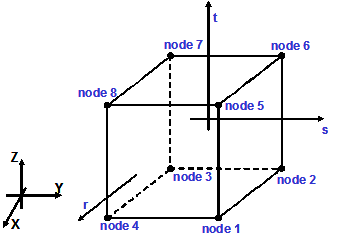Standard Brick Element: Difference between revisions
Jump to navigation
Jump to search
No edit summary |
No edit summary |
||
| Line 31: | Line 31: | ||
NOTE: | NOTE: | ||
#The valid queries to a | #The valid queries to a Brick element when creating an ElementRecorder object are 'forces', 'stresses,' ('strains' version > 2.2.0) and 'material $matNum matArg1 matArg2 ...' Where $matNum refers to the material object at the integration point corresponding to the node numbers in the isoparametric domain. | ||
# This element can only be defined in -ndm 3 -ndf 3 | # This element can only be defined in -ndm 3 -ndf 3 | ||
Latest revision as of 20:05, 12 March 2018
- Command_Manual
- Tcl Commands
- Modeling_Commands
- model
- uniaxialMaterial
- ndMaterial
- frictionModel
- section
- geometricTransf
- element
- node
- sp commands
- mp commands
- timeSeries
- pattern
- mass
- block commands
- region
- rayleigh
- Analysis Commands
- Output Commands
- Misc Commands
- DataBase Commands
This element is used to construct an eight-node brick element object, which uses a trilinear isoparametric formulation.
| element stdBrick $eleTag $node1 $node2 $node3 $node4 $node5 $node6 $node7 $node8 $matTag <$b1 $b2 $b3> |
| $eleTag | unique element object tag |
| $node1 $node2
$node3 $node4 $node5 $node6 $node7 $node8 |
eight nodes defining element boundaries, input order is shown in the figure. |
| $matTag | tag of nDMaterial |
| '$b1 $b2 $b3 | body forces in global x,y,z directions |
NOTE:
- The valid queries to a Brick element when creating an ElementRecorder object are 'forces', 'stresses,' ('strains' version > 2.2.0) and 'material $matNum matArg1 matArg2 ...' Where $matNum refers to the material object at the integration point corresponding to the node numbers in the isoparametric domain.
- This element can only be defined in -ndm 3 -ndf 3
EXAMPLE:
REFERENCES:
Code Developed by: Edward Love, Sandia National Laboratories
